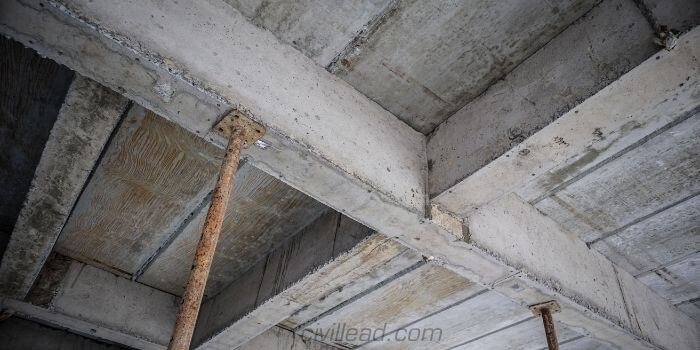Table of Contents
Beam vs Column
A structure mainly consists of a slab, beam, column, and footing. The beam is a horizontal structural component that mainly carries vertical loads.
In contrast, columns are vertical compression members that span from substructure to superstructure and have a vital role in transferring load from the top of the structure to the foundation.
What is Beam?
A beam is a horizontal structural component that resists vertical loads. Its deflection mode is originally by bending. It transfers loads imposed along its length to its endpoints to columns and foundations.
When loads are applied to the beam, consequently reaction forces at the beam’s support ends.
The forces applied to the beam cause shear forces and bending moments inside the beam that induce internal stresses, strains, and deflections.

Beams are classified by their support method, support conditions, cross-section shape, length, and material.
Types of Beam
- Simply Supported
- Continuous Beam
- Over Hanging Beam
- Cantilever Beam
- Fixed Ended Beam
- Reinforced Concrete Beam
- Steel Beam
- Composite Beam
Also, Read – What is Plinth Beam? Plinth Protection, Difference Between Plinth Beam and Tie Beam
What is Column?
It is a vertical structural compression element that bears loads mainly in compression and transfers it to the foundation. It usually transfers loads from superstructure to foundation.
Columns are commonly used to support beams or slabs, or arches. A column is sometimes a decorative element not necessary for structural function, though many columns are embedded, forming part of a wall.
It may also be designed to oppose horizontal forces due to earthquakes and wind. The columns’ location should be specified so that no tensile stresses should be induced at the cross-section.
Column plays an essential role in the entire load transfer system, and without it, the structure can’t exist.

The strength of a column depends mainly on the strength of the material used, length, size, and shape of the column’s cross-section, and geometry.
Also, Read – What is Column? – Types of Column, Reinforcement and Design Procedure
Types of Column
- Square Column
- Rectangular Column
- Circular Column
- Pentagonal Column
- Hexagonal Column
- Octagonal Column
- T-shape Column
- L-shape Column
- Timber Columns
- Masonry Columns
- RCC Columns
- Steel Columns
- Composite Columns
- Axially Loaded Column
- Eccentrically Loaded Column
- Short Column
- Long Column
- A column with longitudinal bar and lateral ties
- A column with longitudinal bar and spiral ties
Difference Between Beam and Column
| S.No. | Beam | Column |
|---|---|---|
| 1. | Generally, horizontal structural component carries loads perpendicular to their longitudinal direction refers to the beam. | Generally, a vertical structural part that takes loads parallel to their longitudinal direction refers to the column. |
| 2. | A beam may be rectangular, square, I-shape, T shape, or H-shape. | A column may be square, rectangular, circular, T-shape, L-shape, C-shape, etc. |
| 3. | The minimum width of the beam is 200 mm. | The column’s minimum width is 200 mm; though, it requires 300mm for earthquake protection. |
| 4. | Beam opposes shear force and bending moment. | Column bears or opposes a compression load. |
| 5. | Mainly, beams are classified based on their support end condition and material type for construction. | Columns are categorized based on their cross-section shape, material for construction, types of loading, slenderness ratio, and lateral reinforcement. |
| 6. | It bears the weight of slabs, floor, building roof, and transfers to columns. | It takes load transferred by beam and ultimately transfers it to the foundation. |
| 7. | In the beam, longitudinal steel is provided on two faces, used to counter bending moment while stirrups or inclined beam opposes the vertical loads. | Longitudinal steel in the column is on all faces, which resist compression. |
| 8. | The beam shows a sign of deflection or cracking before failure or collapse. Its failure does not occur suddenly. | While sometimes in the case of a column, failure or collapse may happen abruptly. It does not necessarily indicate any sign of failure before the collapse. |
| 9. | It is supported by the column at one end or both ends. | The column is entirely erected from the foundation. |
| 10. | The requirement of steel for a beam varies from 0.2% to 2.5%. | The provision of steel for a column differs from 0.8% to 5%. |
| 11. | Beams are usually cast with a slab, and therefore, more excellent care is observed for its construction. | Columns are generally cast in small batches. |
| 12. | Without a beam, a structure can be constructed. | While without a column, a structure can’t be built. |
Also, Read
Difference Between Singly and Doubly Reinforced Beam
Difference Between Long Column and Short Column
Difference Between Beam and Lintel
Load calculation on Column – Load Calculation of Column, Beam, Wall and Slab
What is Concrete Cover? – Clear Cover, Nominal Cover and Effective Cover
excellent work sir
Thanks!